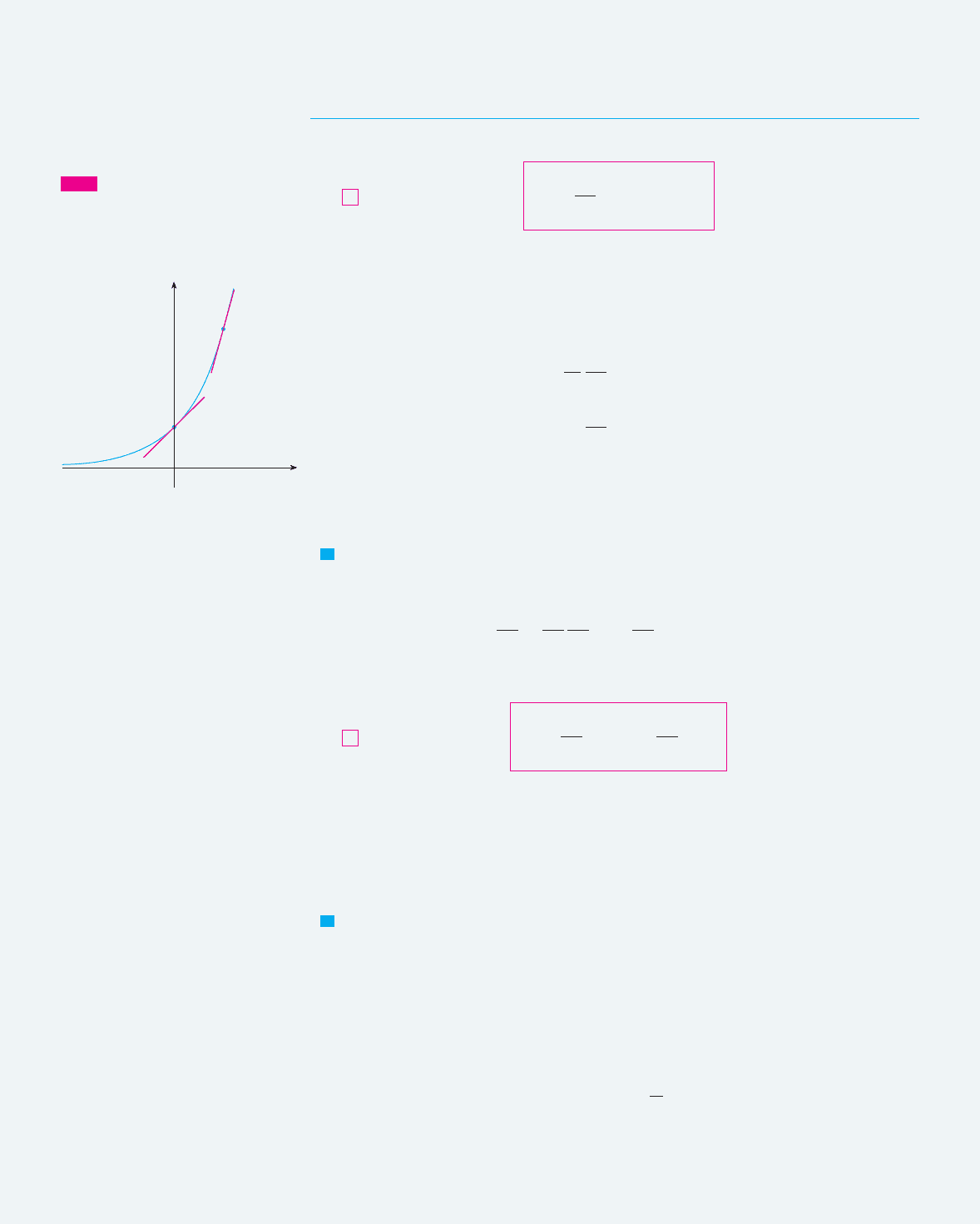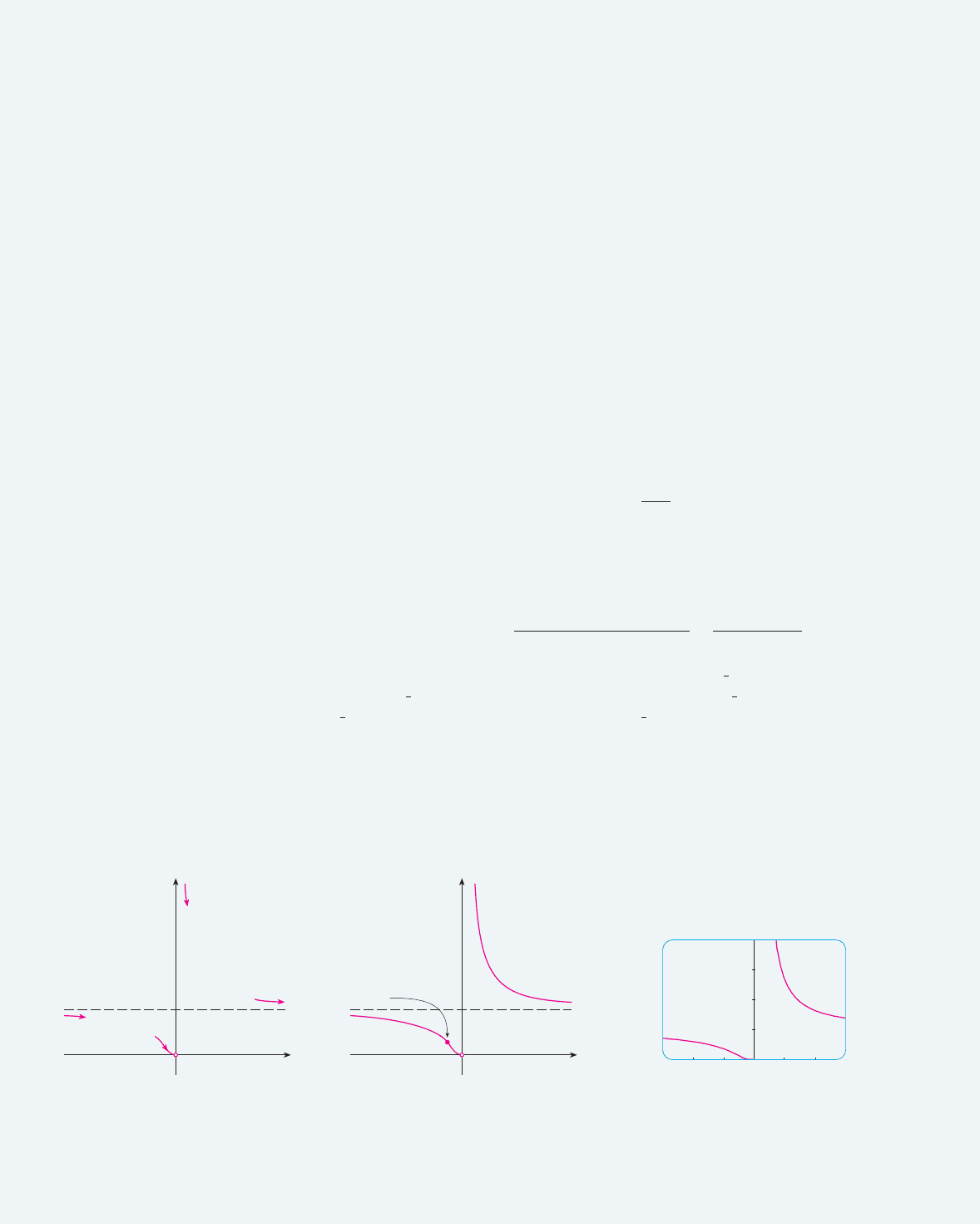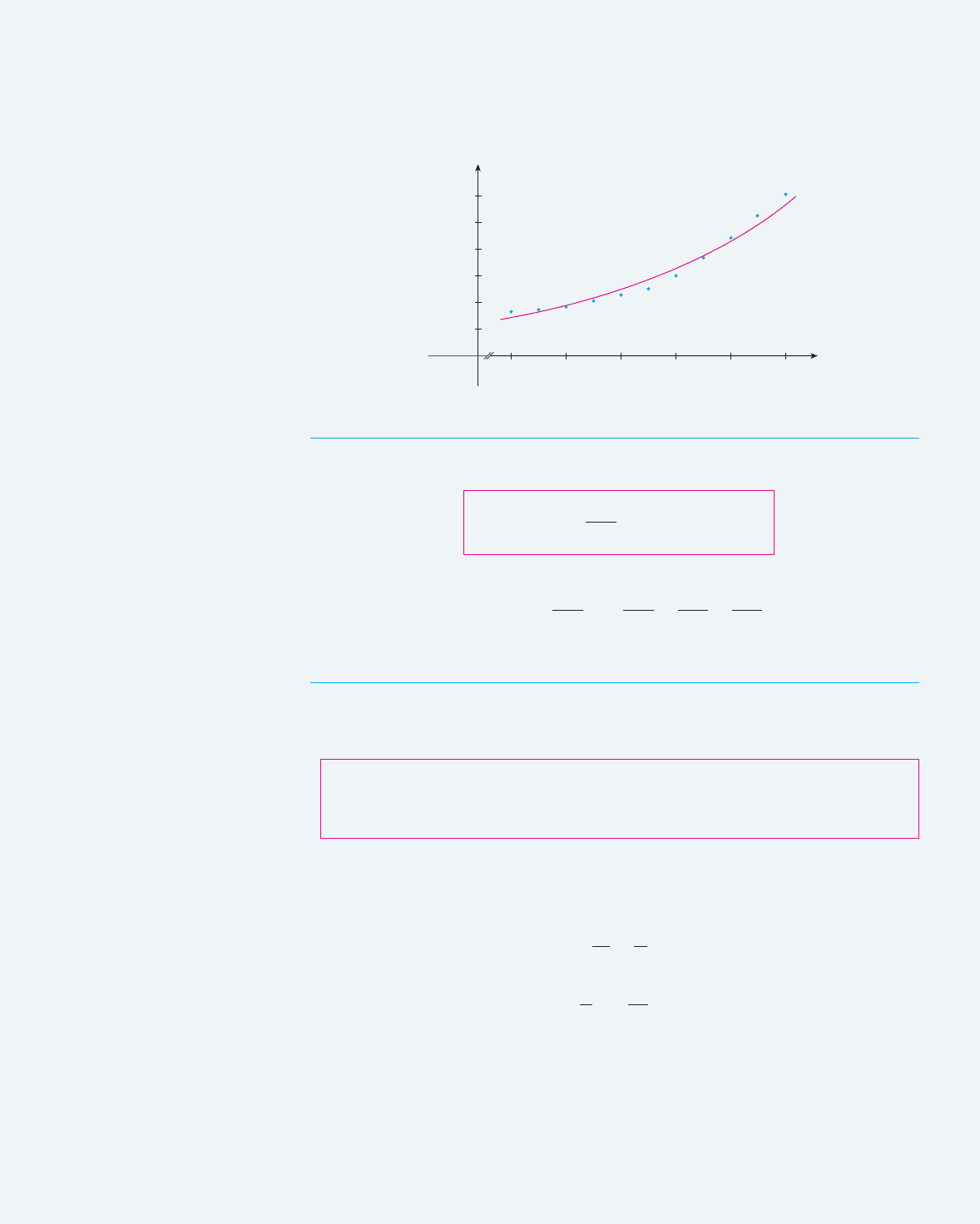Stewart J. Calculus
Подождите немного. Документ загружается.


Since the natural logarithm is found on scientific calculators, we can approximate the
solution to four decimal places: . M
The exponential function is one of the most frequently occurring functions
in calculus and its applications, so it is important to be familiar with its graph (Figure 2)
and its properties (which follow from the fact that it is the inverse of the natural logarith-
mic function).
PROPERTIES OF THE NATURAL EXPONENTIAL FUNCTION The exponential func-
tion is an increasing continuous function with domain and range
. Thus for all . Also
So the -axis is a horizontal asymptote of .
EXAMPLE 3 Find .
SOLUTION We divide numerator and denominator by :
We have used the fact that as and so
M
We now verify that has the properties expected of an exponential function.
LAWS OF EXPONENTS If and are real numbers and is rational, then
1. 2. 3.
PROOF OF LAW 1 Using the first law of logarithms and Equation 5, we have
Since is a one-to-one function, it follows that
Laws 2 and 3 are proved similarly (see Exercises 95 and 96). As we will see in the
next section, Law 3 actually holds when is any real number.
M
r
e
x
e
y
! e
x"y
.ln
ln"e
x
e
y
# ! ln"e
x
# " ln"e
y
# ! x " y ! ln"e
x"y
#
"e
x
#
r
! e
rx
e
x$y
!
e
x
e
y
e
x"y
! e
x
e
y
ryx
7
f "x# ! e
x
lim
x l #
e
$2x
! lim
t l $#
e
t
! 0
x l #t ! $2x l $#
!
1
1 " 0
! 1
lim
x
l
#
e
2x
e
2x
" 1
! lim
x
l
#
1
1 " e
$2x
!
1
1 " lim
x
l
#
e
$2x
e
2x
lim
x l #
e
2x
e
2x
" 1
f "x# ! e
x
x
lim
x l $#
e
x
! 0 lim
x l #
e
x
! #
xe
x
& 0"0, ##
!f "x# ! e
x
6
f "x# ! e
x
x % 0.8991
432
|| ||
CHAPTER 7 INVERSE FUNCTIONS
y=´
x0
1
y
1
F I G U R E 2
The natural exponential function

DIFFERENTIATION
The natural exponential function has the remarkable property that it is its own derivative.
PROOF
The function is differentiable because it is the inverse function of ,
which we know is differentiable with nonzero derivative. To find its derivative, we use
the inverse function method. Let . Then and, differentiating this latter
equation implicitly with respect to , we get
M
The geometric interpretation of Formula 8 is that the slope of a tangent line to the curve
at any point is equal to the -coordinate of the point (see Figure 3). This property
implies that the exponential curve grows very rapidly (see Exercise 100).
EXAMPLE 4
Differentiate the function .
SOLUTION
To use the Chain Rule, we let . Then we have , so
M
In general, if we combine Formula 8 with the Chain Rule, as in Example 4, we get
EXAMPLE 5
Find if .
SOLUTION
Using Formula 9 and the Product Rule, we have
M
EXAMPLE 6
Find the absolute maximum value of the function .
SOLUTION
We differentiate to find any critical numbers:
Since exponential functions are always positive, we see that when ,
that is, when . Similarly, when . By the First Derivative Test for
Absolute Extreme Values, has an absolute maximum value when and the value is
M
f "1# ! "1#e
$1
!
1
e
% 0.37
x ! 1f
x & 1f !"x#
%
0x
%
1
1 $ x & 0f !"x# & 0
f !"x# ! xe
$x
"$1# " e
$x
"1# ! e
$x
"1 $ x#
f "x# ! xe
$x
V
y! ! e
$4x
"cos 5x#"5# " "sin 5x#e
$4x
"$4# ! e
$4x
"5 cos 5x $ 4 sin 5x#
y ! e
$4x
sin 5xy!
d
dx
"e
u
# ! e
u
du
dx
9
dy
dx
!
dy
du
du
dx
! e
u
du
dx
! e
tan x
sec
2
x
y ! e
u
u ! tan x
y ! e
tan x
V
y ! e
x
yy ! e
x
dy
dx
! y ! e
x
1
y
dy
dx
! 1
x
ln y ! xy ! e
x
y ! ln xy ! e
x
d
dx
"e
x
# ! e
x
8
SECTION 7.3* THE NATURAL EXPONENTIAL FUNCTION
|| ||
433
F I G U R E 3
0
y
1
x
slope=1
slope=e®
y=e®
{x,e®}
Visual 7.2 /7.3* uses the slope-a-
scope to illustrate this formula.
TE C
Openmirrors.com

EXAMPLE 7 Use the first and second derivatives of , together with asymp-
totes, to sketch its graph.
SOLUTION Notice that the domain of is , so we check for vertical asymptotes
by computing the left and right limits as . As , we know that ,
so
and this shows that is a vertical asymptote. As , we have ,
so
As , we have and so
This shows that is a horizontal asymptote.
Now let’s compute the derivative. The Chain Rule gives
Since and for all , we have for all . Thus is
decreasing on and on . There is no critical number, so the function has no
maximum or minimum. The second derivative is
Since and , we have when and
when . So the curve is concave downward on and concave upward on
and on . The inflection point is .
To sketch the graph of we first draw the horizontal asymptote (as a dashed
line), together with the parts of the curve near the asymptotes in a preliminary sketch
[Figure 4(a)]. These parts reflect the information concerning limits and the fact that is
decreasing on both and . Notice that we have indicated that as
even though does not exist. In Figure 4(b) we finish the sketch by incorpo-
rating the information concerning concavity and the inflection point. In Figure 4(c) we
check our work with a graphing device.
M
(a) Preliminary sketch (b) Finished sketch
F I G U R E 4
(c) Computer confirmation
4
0
_3 3
x
0
y
y=1
y=‰
inflection
point
x
0
y
y=1
f !0"x l 0
!
f !x" l 0!0, ""!!", 0"
f
y ! 1f
(
!
1
2
, e
!2
)
!0, ""
(
!
1
2
, 0
)
(
!", !
1
2
)
x
#
!
1
2
f $!x"
#
0!x " 0"x % !
1
2
f $!x" % 0x
4
% 0e
1#x
% 0
f $!x" ! !
x
2
e
1#x
!!1#x
2
" ! e
1#x
!2x"
x
4
!
e
1#x
!2x & 1"
x
4
!0, ""!!", 0"
fx " 0f '!x"
#
0x " 0x
2
% 0e
1#x
% 0
f '!x" ! !
e
1#x
x
2
y ! 1
lim
x l("
e
1#x
! e
0
! 1
1#x l 0x l ("
lim
x
l
0
!
e
1#x
! lim
t
l
!"
e
t
! 0
t ! 1#x l !"x l 0
!
x ! 0
lim
x
l
0
&
e
1#x
! lim
t
l
"
e
t
! "
t ! 1#x l "x l 0
&
x l 0
$x
%
x " 0&f
f !x" ! e
1#x
434
|| ||
CHAPTER 7 INVERSE FUNCTIONS

INTEGRATIO N
Because the exponential function has a simple derivative, its integral is also simple:
EXAMPLE 8 Evaluate .
SOLUTION We substitute . Then , so and
M
EXAMPLE 9 Find the area under the curve from 0 to l.
SOLUTION The area is
MA !
y
1
0
e
!3x
dx ! !
1
3
e
!3x
]
0
1
!
1
3
!1 ! e
!3
"
y ! e
!3x
y
x
2
e
x
3
dx !
1
3
y
e
u
du !
1
3
e
u
& C !
1
3
e
x
3
& C
x
2
dx !
1
3
dudu ! 3x
2
dxu ! x
3
y
x
2
e
x
3
dx
V
y
e
x
dx ! e
x
& C
10
y ! e
x
SECTION 7.3* THE NATURAL EXPONENTIAL FUNCTION
|| ||
435
16. (a) (b)
17–20 Make a rough sketch of the graph of the function. Do not
use a calculator. Just use the graph given in Figure 2 and, if neces-
sary, the transformations of Section 1.3.
17. 18.
20.
21–22 Find (a) the domain of and (b) and its domain.
21. 22.
23–26 Find the inverse function.
23. 24. ,
26.
27–32 Find the limit.
27. 28.
29. 30.
31. 32.
lim
x
l
!
)
#2"
&
e
tan x
lim
x
l
"
!e
!2x
cos x"
lim
x
l
2
!
e
3#!2!x"
lim
x
l
2
&
e
3#!2!x"
lim
x
l
"
e
!x
2
lim
x l "
e
3x
! e
!3x
e
3x
& e
!3x
y !
e
x
1 & 2e
x
f !x" ! e
x
3
25.
x * 1y ! !ln x"
2
y ! ln!x & 3"
f!x" ! ln!2 & ln x"f ! x" !
s
3 ! e
2x
f
!1
f
y ! 2!1 ! e
x
"y ! 1 !
1
2
e
!x
19.
y ! 1 & 2e
x
y ! e
!x
e
2!3x
% 4
2
#
ln x
#
9
1. Sketch, by hand, the graph of the function with par-
ticular attention to how the graph crosses the y-axis. What fact
allows you to do this?
2– 4 Simplify each expression.
2. (a) (b)
3. (a) (b)
4. (a) (b)
5–12 Solve each equation for .
5. (a) (b)
6. (a) (b)
7. (a) (b)
8. (a) (b)
9. 10.
11.
13–14 Find the solution of the equation correct to four decimal
places.
13. (a) (b)
14. (a) (b)
15–16 Solve each inequality for .
15. (a) (b) ln x % !1
e
x
#
10
x
e
1#!x!4"
! 7ln
(
1 &
s
x
)
! 2
ln!e
x
! 2" ! 3e
2&5x
! 100
ln!2x & 1" ! 2 ! ln x
12.
e
2x
! e
x
! 6 ! 0
10!1 & e
!x
"
!1
! 33xe
x
& x
2
e
x
! 0
e
e
x
! 10ln!ln x" ! 1
ln x & ln!x ! 1" ! 1e
3x&1
! k
ln!5 ! 2x" ! !3e
2x& 3
! 7 ! 0
e
!x
! 52 ln x ! 1
x
e
x & ln x
ln e
sin x
ln
(
ln e
e
10
)
e
!2 ln 5
ln!1#e"e
ln 15
f !x" ! e
x
E X E R C I S E S
7.3*

436
|| ||
CHAPTER 7 INVERSE FUNCTIONS
tion 10.4 we will see that this is a reasonable equation
for .]
(a) Find .
(b) Find the rate of spread of the rumor.
;
(c) Graph for the case , with measured in
hours. Use the graph to estimate how long it will take for
80% of the population to hear the rumor.
;
62. For the period from 1980 to 2000, the percentage of house-
holds in the United States with at least one VCR has been
modeled by the function
where the time is measured in years since midyear 1980, so
. Use a graph to estimate the time at which the
number of VCRs was increasing most rapidly. Then use
derivatives to give a more accurate estimate.
63. Find the absolute maximum value of the function
.
64. Find the absolute minimum value of the function
, .
65–66 Find the absolute maximum and absolute minimum values
of on the given interval.
65. , 66. ,
67–68 Find (a) the intervals of increase or decrease, (b) the inter-
vals of concavity, and (c) the points of inflection.
67. 68.
69–70 Discuss the curve using the guidelines of Section 4.5.
70.
;
71. A drug response curve describes the level of medication in
the bloodstream after a drug is administered. A surge
function is often used to model the response
curve, reflecting an initial surge in the drug level and then a
more gradual decline. If, for a particular drug,
, and is measured in minutes, estimate the
times corresponding to the inflection points and explain their
significance. If you have a graphing device, use it to graph
the drug response curve.
;
72–73 Draw a graph of that shows all the important aspects of
the curve. Estimate the local maximum and minimum values and
then use calculus to find these values exactly. Use a graph of
to estimate the inflection points.
72. 73. f !x" ! e
x
3
!x
f !x" ! e
cos x
f $
f
tp ! 4, k ! 0.07
A ! 0.01,
S!t" ! At
p
e
!kt
y ! e
2 x
! e
x
y ! e
!1#!x&1"
69.
f !x" !
e
x
x
2
f !x" ! !1 ! x"e
!x
'!1, 6(f !x" ! x
2
e
!x#2
'!1, 4(f !x" ! xe
!x
2
#8
f
x % 0t!x" ! e
x
#x
f !x" ! x ! e
x
0 + t + 20
t
V!t" !
85
1 & 53e
!0.5t
tk ! 0.5a ! 10p
lim
t
l
"
p!t"
p!t"
33 – 48 Differentiate the function.
33. 34.
36.
37. 38.
40.
41. 42.
43. 44.
45. 46.
47. 48.
49–50 Find an equation of the tangent line to the curve at the
given point.
49.
Find if .
52. Find an equation of the tangent line to the curve
at the point .
53. Show that the function satisfies the differen-
tial equation .
54. Show that the function satisfies the differ-
ential equation .
55. For what values of does the function satisfy the
equation ?
56. Find the values of for which satisfies the equation
.
If , find a formula for .
58. Find the thousandth derivative of .
59. (a) Use the Intermediate Value Theorem to show that there is
a root of the equation .
(b) Use Newton’s method to find the root of the equation in
part (a) correct to six decimal places.
;
60. Use a graph to find an initial approximation (to one decimal
place) to the root of the equation .
Then use Newton’s method to find the root correct to eight
decimal places.
61. Under certain circumstances a rumor spreads according to the
equation
where is the proportion of the population that knows the
rumor at time and and are positive constants. [In Sec-
kat
p!t"
p!t" !
1
1 & ae
!k t
4e
!x
2
sin x ! x
2
! x & 1
e
x
& x ! 0
f !x" ! xe
!x
f
!n"
!x"f !x" ! e
2x
57.
y & y' ! y$
y ! e
,
x
,
y$ & 6y' & 8y ! 0
y ! e
rx
r
y$ & 2y' & y ! 0
y ! Ae
!x
& Bxe
!x
2y$ ! y' ! y ! 0
y ! e
x
& e
! x / 2
!0, 1"xe
y
& ye
x
! 1
e
x
2
y
! x & yy'
51.
y ! e
x
#x, !1, e"
50.
y ! e
2x
cos
)
x, !0, 1"
f !t" ! sin
2
!e
sin
2
t
"y ! cos
)
1 ! e
2x
1 & e
2x
*
y !
s
1 & xe
!2x
y !
ae
x
& b
ce
x
& d
y !
e
u
! e
!u
e
u
& e
!u
y ! e
e
x
y ! e
k tan
s
x
y !
s
1 & 2e
3x
f !t" ! sin!e
t
" & e
sin t
F!t" ! e
t sin 2t
39.
t!x" !
s
x
e
x
f !u" ! e
1#u
y ! e
u
!cos u & cu"y ! e
ax
3
35.
y !
e
x
1 & x
f !x" ! !x
3
& 2x"e
x

91. If , find .
92. Evaluate .
;
93. If you graph the function
you’ll see that appears to be an odd function. Prove it.
;
94. Graph several members of the family of functions
where . How does the graph change when changes?
How does it change when changes?
95. Prove the second law of exponents [see (7)].
96. Prove the third law of exponents [see (7)].
97. (a) Show that if .
[Hint: Show that is increasing
for .]
(b) Deduce that .
98. (a) Use the inequality of Exercise 97(a) to show that, for
(b) Use part (a) to improve the estimate of given in
Exercise 97(b).
99. (a) Use mathematical induction to prove that for and
any positive integer ,
(b) Use part (a) to show that .
(c) Use part (a) to show that
for any positive integer .
;
100. This exercise illustrates Exercise 99(c) for the case .
(a) Compare the rates of growth of and
by graphing both and in several viewing rectangles.
When does the graph of finally surpass the graph of ?
(b) Find a viewing rectangle that shows how the function
behaves for large .
(c) Find a number such that
if then
e
x
x
10
% 10
10
x % N
N
xh!x" ! e
x
#x
10
ft
tf
t!x" ! e
x
f !x" ! x
10
k ! 10
k
lim
x l "
e
x
x
k
! "
e % 2.7
e
x
* 1 & x &
x
2
2!
& - - - &
x
n
n!
n
x * 0
x
1
0
e
x
2
dx
e
x
* 1 & x &
1
2
x
2
x * 0,
4
3
+ x
1
0
e
x
2
dx + e
x % 0
f !x" ! e
x
! !1 & x"
x * 0e
x
* 1 & x
a
ba % 0
f !x" !
1
1 & ae
bx
f
f !x" !
1 ! e
1#x
1 & e
1#x
lim
x l
)
e
sin x
! 1
x !
)
! f
!1
"'!4"f !x" ! 3 & x & e
x
74. The family of bell-shaped curves
occurs in probability and statistics, where it is called the nor-
mal density function. The constant is called the mean and
the positive constant is called the standard deviation. For
simplicity, let’s scale the function so as to remove the factor
and let’s analyze the special case where .
So we study the function
(a) Find the asymptote, maximum value, and inflection points
of .
(b) What role does play in the shape of the curve?
;
(c) Illustrate by graphing four members of this family on the
same screen.
75– 84 Evaluate the integral.
75. 76.
78.
79. 80.
81. 82.
84.
85. Find, correct to three decimal places, the area of the region
bounded by the curves , , and .
86. Find if , , and .
87. Find the volume of the solid obtained by rotating about the
-axis the region bounded by the curves , , ,
and .
Find the volume of the solid obtained by rotating about the
-axis the region bounded by the curves , ,
, and .
89. The error function
is used in probability, statistics, and engineering.
(a) Show that .
(b) Show that the function satisfies the differ-
ential equation .
90. A bacteria population starts with 400 bacteria and grows at a
rate of bacteria per hour. How many
bacteria will there be after three hours?
r!t" ! !450.268"e
1.12567t
y' ! 2xy & 2#
s
)
y ! e
x
2
erf!x"
x
b
a
e
!t
2
dt !
1
2
s
)
'erf!b" ! erf!a"(
erf!x" !
2
s
)
y
x
0
e
!t
2
dt
x ! 1x ! 0
y ! 0y ! e
!x
2
y
88.
x ! 1
x ! 0y ! 0y ! e
x
x
f '!0" ! 2f !0" ! 1f $!x" ! 3e
x
& 5 sin xf !x"
x ! 1y ! e
3x
y ! e
x
y
e
x
sin!e
x
" dx
y
e
s
x
s
x
dx
83.
y
e
1#x
x
2
dx
y
sin x e
cos x
dx
y
e
x
!4 & e
x
"
5
dx
y
!e
x
& e
!x
"
2
dx
y
!1 & e
x
"
2
e
x
dx
y
e
x
s
1 & e
x
dx
77.
y
1
0
xe
!x
2
dx
y
5
0
e
!3x
dx
.
f
f !x" ! e
!x
2
#!2
.
2
"
/
! 01#
(
.
s
2
)
)
.
/
y !
1
.
s
2
)
e
!!x!
/
"
2
#!2
.
2
"
SECTION 7.3* THE NATURAL EXPONENTIAL FUNCTION
|| ||
437

438
|| ||
CHAPTER 7 INVERSE FUNCTIONS
GEN ERAL LOG ARIT HMIC AND EXP ONEN TIA L FUN CTI ONS
In this section we use the natural exponential and logarithmic functions to study exponen-
tial and logarithmic functions with base .
GENERAL EXPONEN T I A L F U N C TI O N S
If and is any rational number, then by (4) and (7) in Section 7.3*,
Therefore, even for irrational numbers , we define
Thus, for instance,
The function is called the exponential function with base a. Notice that is
positive for all because is positive for all .
Definition 1 allows us to extend one of the laws of logarithms. We know that
when is rational. But if we now let be any real number we have, from
Definition 1,
Thus
The general laws of exponents follow from Definition 1 together with the laws of expo-
nents for .
LAWS OF EXPONENTS If and are real numbers and , , then
1. 2. 3. 4.
PROOF
1. Using Definition 1 and the laws of exponents for , we have
3. Using Equation 2 we obtain
The remaining proofs are left as exercises. M
! e
xy ln a
! a
xy
!a
x
"
y
! e
y ln!a
x
"
! e
yx ln a
! e
x ln a
e
y ln a
! a
x
a
y
a
x&y
! e
!x&y" ln a
! e
x ln a & y ln a
e
x
!ab"
x
! a
x
b
x
!a
x
"
y
! a
xy
a
x!y
! a
x
#a
y
a
x&y
! a
x
a
y
b % 0ayx
3
e
x
ln a
r
! r ln a for any real number r
2
ln a
r
! ln!e
r ln a
" ! r ln a
rrln!a
r
" ! r ln a
xe
x
x
a
x
f !x" ! a
x
2
s
3
! e
s
3 ln 2
+ e
1.20
+ 3.32
a
x
! e
x ln a
1
x
a
r
! !e
ln a
"
r
! e
r ln a
ra % 0
a % 0
7.4*

The differentiation formula for exponential functions is also a consequence of
Definition 1:
PROOF M
Notice that if , then and Formula 4 simplifies to a formula that we
already know: . In fact, the reason that the natural exponential function is
used more often than other exponential functions is that its differentiation formula is
simpler.
EXAMPLE 1 In Example 6 in Section 3.7 we considered a population of bacteria cells in
a homogeneous nutrient medium. We showed that if the population doubles every hour,
then the population after hours is
where is the initial population. Now we can use (4) to compute the growth rate:
For instance, if the initial population is cells, then the growth rate after two
hours is
M
EXAMPLE 2 Combining Formula 4 with the Chain Rule, we have
M
EXPONENTIA L GRA P H S
If , then , so , which shows that is increas-
ing (see Figure 1). If , then and so is decreasing (see Figure 2).
F I G U R E 1
y=a®, a>1
F I G U R E 2
y=a®,0<a<1
x
lim a®=0, lim a®=`
x
_`
x
`
0
y
1
x
lim a®=`, lim a®=0
x
_`
x
`
0
y
1
y ! a
x
ln a
#
00
#
a
#
1
y ! a
x
!d#dx" a
x
! a
x
ln a % 0ln a % 0a % 1
d
dx
(
10
x
2
)
! 10
x
2
!ln 10"
d
dx
!x
2
" ! !2 ln 10"x10
x
2
! 4000 ln 2 + 2773 cells#h
dn
dt
,
t!2
! !1000"2
t
ln 2
%
t!2
n
0
! 1000
dn
dt
! n
0
2
t
ln 2
n
0
n ! n
0
2
t
t
!d#dx" e
x
! e
x
ln e ! 1a ! e
! a
x
ln a
d
dx
!a
x
" !
d
dx
!e
x ln a
" ! e
x ln a
d
dx
!x ln a"
d
dx
!a
x
" ! a
x
ln a
4
SECTION 7.4* GENERAL LOGARITHMIC AND EXPONENTIAL FUNCTIONS
|| ||
439

Notice from Figure 3 that as the base a gets larger, the exponential function grows more
rapidly (for ).
Figure 4 shows how the exponential function compares with the power function
. The graphs intersect three times, but ultimately the exponential curve
grows far more rapidly than the parabola . (See also Figure 5.)
In Section 7.5 we will show how exponential functions occur in the description of pop-
ulation growth and radioactive decay. Let’s look at human population growth. Table 1
shows data for the population of the world in the 20th century and Figure 6 shows the cor-
responding scatter plot.
The pattern of the data points in Figure 6 suggests exponential growth, so we use a
graphing calculator with exponential regression capability to apply the method of least
squares and obtain the exponential model
Figure 7 shows the graph of this exponential function together with the original data
points. We see that the exponential curve fits the data reasonably well. The period of rela-
P ! !0.008079266" ! !1.013731"
t
F I G U R E 6 Scatter plot for world population growth
1900
6x10'
P
t
1920 1940 1960 1980 2000
y ! x
2
y ! 2
x
y ! x
2
y ! 2
x
F I G U R E 3
x
0
y
2
y=2®
4
y=≈
100
200
6
F I G U R E 5
x
0
y
2
4
10
y=2®
y=≈
F I G U R E 4
1.5®
x
0
y
1
1®
2®
4®
10®
”’
®
1
4
”’
®
1
2
e®
x % 0
440
|| ||
CHAPTER 7 INVERSE FUNCTIONS
TA B L E 1
Population
Year (millions)
1900 1650
1910 1750
1920 1860
1930 2070
1940 2300
1950 2560
1960 3040
1970 3710
1980 4450
1990 5280
2000 6080
Members of the family of
exponential functions

tively slow population growth is explained by the two world wars and the Great Depres-
sion of the 1930s.
EXPONENTIA L INT E G R A LS
The integration formula that follows from Formula 4 is
EXAMPLE 3 M
THE POWE R RU L E VERSUS TH E E X P O N EN T I A L RULE
Now that we have defined arbitrary powers of numbers, we are in a position to prove the
general version of the Power Rule, as promised in Section 3.3.
THE POWER RULE If is any real number and , then
PROOF Let and use logarithmic differentiation:
Therefore
Hence
M
|
You should distinguish carefully between the Power Rule , where
the base is variable and the exponent is constant, and the rule for differentiating exponen-
tial functions , where the base is constant and the exponent is variable.
'!d#dx" a
x
! a
x
ln a(
'!d#dx" x
n
! nx
n!1
(
y' ! n
y
x
! n
x
n
x
! nx
n!1
y'
y
!
n
x
x " 0ln
%
y
%
! ln
%
x
%
n
! n ln
%
x
%
y ! x
n
f '!x" ! nx
n!1
f !x" ! x
n
n
y
5
0
2
x
dx !
2
x
ln 2
-
0
5
!
2
5
ln 2
!
2
0
ln 2
!
31
ln 2
a " 1
y
a
x
dx !
a
x
ln a
& C
F I G U R E 7
Exponential model for
population growth
1900
6x10'
P
t
1920 1940 1960 1980 2000
SECTION 7.4* GENERAL LOGARITHMIC AND EXPONENTIAL FUNCTIONS
|| ||
441
N If , we can show that for
directly from the definition of a derivative.
n % 1
f '!0" ! 0x ! 0
